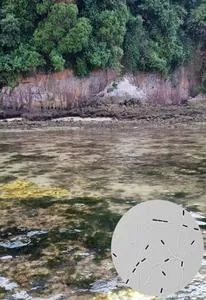
Revolutionary Kelp-Eating Microalgae: The Future of Biotechnology?
2025-06-26
Author: Arjun
Meet the Unusual Hero: Nitzschia sing1
In the vast ocean, a remarkable group of algae known as diatoms boasts over 100,000 unique species. Traditionally, these microscopic entities harness the power of sunlight for photosynthesis, transforming carbon dioxide and water into energy. However, one particular species, whimsically dubbed Nitzschia sing1, has thrown a curveball into the mix.
Adaptation Beyond Photosynthesis
Professor Finn L. Aachmann from the Norwegian University of Science and Technology (NTNU) leads a groundbreaking research team studying Nitzschia sing1. Unlike its brethren, this extraordinary diatom has abandoned photosynthesis entirely, opting instead to feast on kelp! The findings, published in PLOS Biology, reveal how this adaptation has opened new avenues within the oceanic ecosystem.
Nature's Own Biorefinery
So, how does Nitzschia sing1 get its energy? The secret lies in specialized genes that produce enzymes capable of breaking down alginate—a sugar prominent in the cell walls of brown algae. Aachmann triumphantly refers to these diatoms as 'nature’s own biorefinery,' hinting at their potential to revolutionize biotechnology.
A Genetic Gift from Bacteria
Intriguingly, researchers posit that the genetic prowess of Nitzschia sing1 traces back to ancient marine bacteria. This diatom apparently absorbed essential genes from its bacterial counterparts, allowing it to adapt through numerous mutations—a perfect example of evolution in action. By shedding its need for photosynthesis, this diatom uncovered a new ecological niche, thriving in tide pools where kelp flourishes.
Unlocking the Potential of Kelp
But why does this matter? Understanding how Nitzschia sing1 obtains its nutrients opens up exciting possibilities for harnessing kelp in various industries. Alginate derived from kelp is a key ingredient in over 600 products, ranging from ice creams and gels to welding rods and medical bandages.
A Gateway to Innovation
The implications of this research extend far beyond the culinary and cosmetic industries. Insights gained from these diatoms could influence the development of biofuels, sustainable animal feed, carbon recycling methods, and even evolutionary biology studies. Who knew that a small, rule-breaking diatom could inspire a wave of technological advancements?
Funded by Temasek, the Research Council of Norway, and Deutsche Forschungsgemeinschaft, this research showcases how the smallest organisms can have the biggest impacts on our understanding of biology and its practical applications.


 Brasil (PT)
Brasil (PT)
 Canada (EN)
Canada (EN)
 Chile (ES)
Chile (ES)
 Česko (CS)
Česko (CS)
 대한민국 (KO)
대한민국 (KO)
 España (ES)
España (ES)
 France (FR)
France (FR)
 Hong Kong (EN)
Hong Kong (EN)
 Italia (IT)
Italia (IT)
 日本 (JA)
日本 (JA)
 Magyarország (HU)
Magyarország (HU)
 Norge (NO)
Norge (NO)
 Polska (PL)
Polska (PL)
 Schweiz (DE)
Schweiz (DE)
 Singapore (EN)
Singapore (EN)
 Sverige (SV)
Sverige (SV)
 Suomi (FI)
Suomi (FI)
 Türkiye (TR)
Türkiye (TR)
 الإمارات العربية المتحدة (AR)
الإمارات العربية المتحدة (AR)